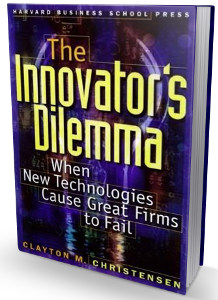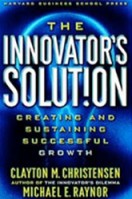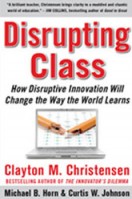Raymond Morel
2790 days ago
From Wikipedia
-
The Innovator's Dilemma
From Wikipedia, the free encyclopediaThe Innovator's Dilemma 
Author Clayton Christensen Country United States Language English Genre Business theory Publisher Harvard Business Review Press; 1st edition (May 1, 1997) Publication date1997 ISBN 0875845851 Followed by ''The Innovator's Solution'' The Innovator's Dilemma: When New Technologies Cause Great Firms to Fail, generally referred to as The Innovator's Dilemma, first published in 1997, is the most well-known work of the Harvard professor and businessman Clayton Christensen.
Contents
Subject matter
Christensen's book suggests that successful companies can put too much emphasis on customers' current needs, and fail to adopt new technology or business models that will meet their customers' unstated or future needs. He argues that such companies will eventually fall behind. Christensen calls the anticipation of future needs "disruptive innovation," and gives examples involving the personal computer industry, earth movers, and steel minimills.
As the title states, the innovator’s ‘dilemma’ comes from the idea that businesses or organizations will reject innovations based on the fact that customers cannot currently use them, thus allowing these ideas with great potential to go to waste. Christensen goes into great detail about the way in which ‘successful’ companies adhered to customer needs, adopted new technologies and took rivals into consideration, but still ended up losing dominance in their market.
Reception
Shortly after the release of the book, Christensen "received the Global Business Book Award for The Innovator’s Dilemma and The Economist named it as one of the six most important books about business ever written".[1] It also received the Global Business Book Award as the best business book of the year (1997).[2]
Criticism
One criticism of the book by Ben Thompson[3] is that the theory applies best to businesses with business customers. Thompson says that consumers are not as rational and single-minded as business customers, and hence are less susceptible to disruption. Thompson points to the iPhone as a consumer product that is not easily disrupted by a low-end disruption; Christensen maintains that the iPhone and Apple are good candidates for disruption.[4]
Impact on business world
Christensen at the World Economic Forum Annual Meeting in 2013The term disruptive technologies was first described in depth with this book by Christensen; but the term was later changed to disruptive innovation in a later book (The Innovator's Solution). A disruptive innovation is an innovation that creates a new market and value network that will eventually disrupt an already existing market and replace an existing product.
The Innovator's Dilemma proved popular; not only was it reprinted,[5] but a follow-on book entitled "The Innovator's Solution" was published.[6] His books "Disrupting Class"[7] about education and "The Innovator's Prescription"[8] about health care both utilize ideas from the Innovator's Dilemma.
References
- "Aiming high", Jun 30th 2011. http:/
/ www.economist.com/ node/ 18894875 - Innosight,(2014). Clayton Christensen-Innosight Co-founder. [online] Available at: http:/
/ www.innosight.com/ about-us/ clayton-christensen.cfm [Accessed 15 Oct. 2014]. - Thompson, Ben. "What Clayton Christensen Got Wrong" . Stratechery. Retrieved 1 November 2014.
- Blodget, Henry. "Harvard Management Legend Clay Christensen Defends His 'Disruption' Theory, Explains The Only Way Apple Can Win" . Business Insider. Retrieved 1 November 2014.
- Christensen, Clayton (2011). The Innovator's Dilemma: The Revolutionary Book That Will Change the Way You Do Business. HarperBusiness. p. 336. ISBN 0062060244.
- Christensen, Clayton (2003). The Innovator's Solution: Creating and Sustaining Successful Growth. Harvard Business School Press. ISBN 1578518520.
- Christensen, Clayton; Johnson, Curtis; Horn, Michael (2010). Disrupting Class: How Disruptive Innovation Will Change the Way the World Learns (2 ed.). p. 272. ISBN 9780071749107.
Books
The Innovator’s Dilemma: When New Technologies Cause Great Firms to Fail
Book Description
In this revolutionary bestseller, Clayton Christensen demonstrates how successful, outstanding companies can do everything “right” and yet still lose their market leadership – or even fail – as new, unexpected competitors rise and take over the market. Through this compelling multi-industry study, Christensen introduces his seminal theory of “disruptive innovation” that has changed the way managers and CEOs around the world think about innovation.
While decades of researchers have struggled to understand why even the best companies almost inevitably fail, Christensen shows how most companies miss out on new waves of innovation. His answer is surprising and almost paradoxic: it is actually the same practices that lead the business to be successful in the first place that eventually can also result in their eventual demise. This breakthrough insight has made The Innovator’s Dilemma a must-read for managers, CEOs, innovators, and entrepreneurs alike.
Featured Review
“A masterpiece….the most profound and useful business book ever written about innovation.”
George Gilder
The Gilder Report
Other Key Concepts
-
Organizational Capabilities
Resources, processes and priorities
-
Jobs to be Done
Finding the right customers for your product
-
Theory of Theory Building
What makes good theory
-
Reinventing Your Business Model
Why, when, and how
-
Integration vs. Modularity
Identifying where the money will be
-
Tools of Cooperation
How to build consensus
Disruptive Innovation
Disruptive innovation, a term of art coined by Clayton Christensen, describes a process by which a product or service takes root initially in simple applications at the bottom of a market and then relentlessly moves up market, eventually displacing established competitors.

Some examples of disruptive innovation include:
| Disruptor | Disruptee |
|---|---|
| Personal computers | Mainframe and mini computers |
| Mini mills | Integrated steel mills |
| Cellular phones | Fixed line telephony |
| Community colleges | Four-year colleges |
| Discount retailers | Full-service department stores |
| Retail medical clinics | Traditional doctor’s offices |
As companies tend to innovate faster than their customers’ needs evolve, most organizations eventually end up producing products or services that are actually too sophisticated, too expensive, and too complicated for many customers in their market.
Companies pursue these “sustaining innovations” at the higher tiers of their markets because this is what has historically helped them succeed: by charging the highest prices to their most demanding and sophisticated customers at the top of the market, companies will achieve the greatest profitability.
However, by doing so, companies unwittingly open the door to “disruptive innovations” at the bottom of the market. An innovation that is disruptive allows a whole new population of consumers at the bottom of a market access to a product or service that was historically only accessible to consumers with a lot of money or a lot of skill.
Characteristics of disruptive businesses, at least in their initial stages, can include: lower gross margins, smaller target markets, and simpler products and services that may not appear as attractive as existing solutions when compared against traditional performance metrics. Because these lower tiers of the market offer lower gross margins, they are unattractive to other firms moving upward in the market, creating space at the bottom of the market for new disruptive competitors to emerge.
http:/








